2007 MERCEDES-BENZ C-CLASS ESTATE manual transmission
[x] Cancel search: manual transmissionPage 331 of 377
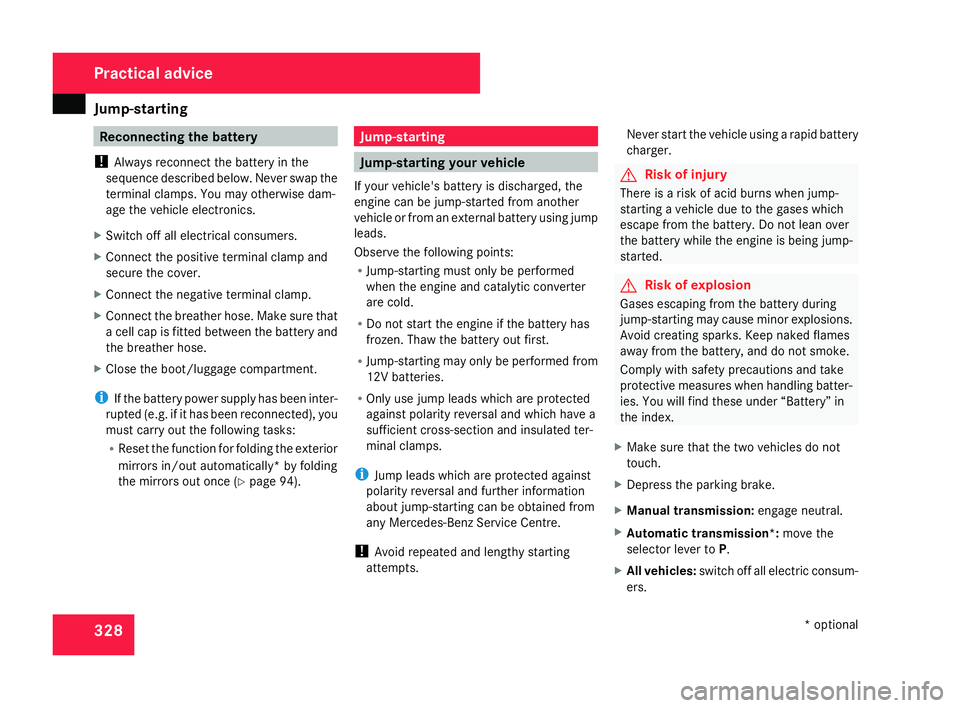
Jump-starting
328 Reconnecting the battery
! Always reconnect the battery in the
sequence described below. Never swap the
terminal clamps. You may otherwise dam-
age the vehicle electronics.
X Switch off all electrical consumers .
X Connect the positive terminal clamp and
secure the cover .
X Connect the negative terminal clamp.
X Connect the breather hose. Make sure that
a cell cap is fitted between the battery and
the breather hose.
X Close the boot/luggage compartment.
i If the battery power supply has been inter-
rupted (e.g. if it has been reconnected), you
must carry out the following tasks:
R Reset the function for folding the exterio r
mirrors in/out automatically* by folding
the mirrors out once (Y page 94). Jump-starting
Jump-starting your vehicle
If your vehicle's battery is discharged, the
engine can be jump-started from another
vehicle or from an external battery using jump
leads.
Observe the following points:
R Jump-starting must only be performed
when the engine and catalytic converte r
are cold.
R Do not start the engine if the battery ha s
frozen. Thaw the battery out first.
R Jump-starting may only be performed from
12V batteries .
R Only use jump leads which are protected
against polarity reversal and which have a
sufficient cross-section and insulated ter-
minal clamps.
i Jump leads which are protected against
polarity reversal and further informatio n
about jump-starting can be obtained from
any Mercedes-Benz Service Centre.
! Avoid repeated and lengthy starting
attempts. Never start the vehicle using a rapid battery
charger. G
Risk of injury
There is a risk of acid burns when jump -
starting a vehicle due to the gases which
escape from the battery. Do not lean over
the battery while the engine is being jump-
started. G
Risk of explosion
Gases escaping from the battery during
jump-starting may cause minor explosions.
Avoid creating sparks. Keep naked flames
away from the battery, and do not smoke .
Comply with safety precautions and tak e
protective measures when handling batter-
ies. You will find these under “Battery” in
the index .
X Make sure that the two vehicles do not
touch.
X Depress the parking brake.
X Manual transmission: engage neutral.
X Automatic transmission*: move the
selector lever to P.
X All vehicles: switch off all electric consum-
ers . Practical advice
* optional
204_AKB; 2; 3, en-GB
mkalafa,
2007-06-26T23:11:51+02:00 - Seite 328
Page 334 of 377
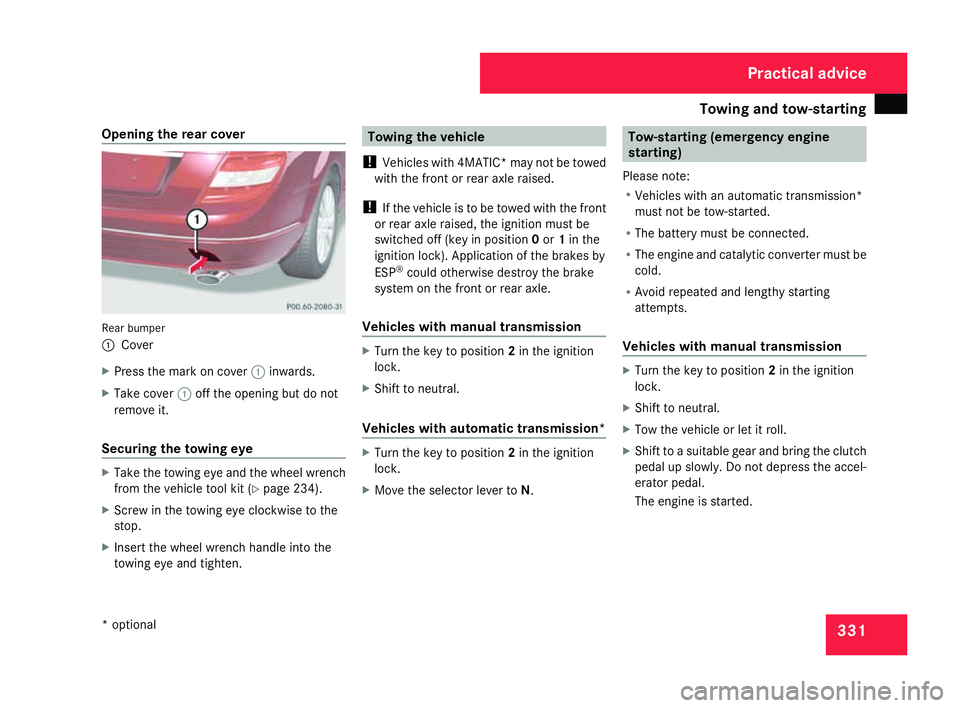
Towing and tow-startin
g 331
Opening the rear cover
Rear bumper
1
Cove r
X Press the mark on cover 1inwards.
X Take cover 1off the opening but do not
remove it.
Securing the towing eye X
Take the towing eye and the wheel wrench
from the vehicle tool kit (Y page 234).
X Screw in the towing eye clockwise to the
stop .
X Insert the wheel wrench handle into the
towing eye and tighten. Towing the vehicle
! Vehicles with 4MATIC* may not be towed
with the front or rear axle raised.
! If the vehicle is to be towed with the front
or rear axle raised, the ignition must be
switched off (key in position 0or 1in the
ignition lock). Application of the brakes by
ESP ®
could otherwise destroy the brake
system on the front or rear axle.
Vehicles with manual transmission X
Turn the key to position 2in the ignition
lock .
X Shift to neutral .
Vehicles with automatic transmission * X
Turn the key to position 2in the ignition
lock .
X Move the selector lever to N. Tow-starting (emergency engine
starting )
Please note:
R Vehicles with an automatic transmission*
must not be tow-started.
R The battery must be connected.
R The engine and catalytic converter must be
cold.
R Avoid repeated and lengthy starting
attempts .
Vehicles with manual transmission X
Turn the key to position 2in the ignition
lock .
X Shift to neutral .
X Tow the vehicle or let it roll.
X Shift to a suitable gear and bring the clutch
pedal up slowly. Do not depress the accel-
erator pedal.
The engine is started. Practical advice
* optiona l
204_AKB; 2; 3, en-GB
mkalafa,
2007-06-26T23:11:51+02:00 - Seite 331
Page 335 of 377
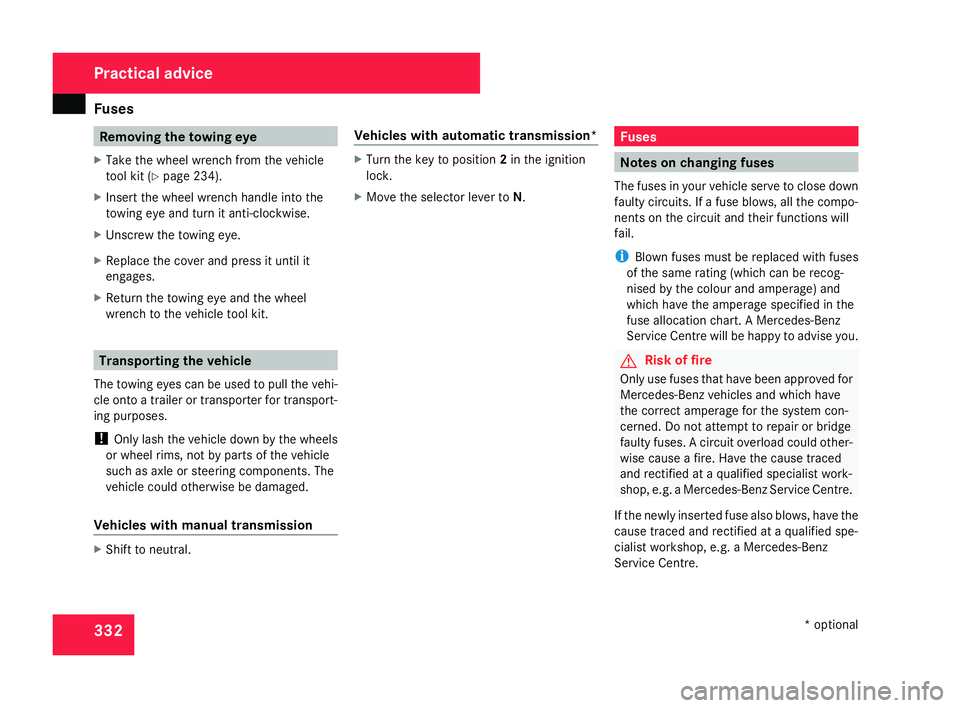
Fuse
s 332 Removing the towing eye
X Take the wheel wrench from the vehicle
tool kit (Y page 234).
X Insert the wheel wrench handle into the
towing eye and turn it anti-clockwise.
X Unscrew the towing eye.
X Replace the cover and press it until it
engages.
X Return the towing eye and the whee l
wrench to the vehicle tool kit .Transporting the vehicle
The towing eyes can be used to pull the vehi-
cle onto a trailer or transporter for transport-
ing purposes.
! Only lash the vehicle down by the wheels
or wheel rims, not by parts of the vehicl e
such as axle or steering components. The
vehicle could otherwise be damaged.
Vehicles with manual transmission X
Shift to neutral . Vehicles with automatic transmission
* X
Turn the key to position 2in the ignition
lock .
X Move the selector lever to N. Fuses
Notes on changing fuses
The fuses in your vehicle serve to close down
faulty circuits. If a fuse blows, all the compo -
nents on the circuit and their functions will
fail .
i Blown fuses must be replaced with fuses
of the same rating (which can be recog -
nised by the colour and amperage) and
which have the amperage specified in the
fuse allocation chart. A Mercedes-Benz
Service Centre will be happy to advise you. G
Risk of fire
Only use fuses that have been approved for
Mercedes-Benz vehicles and which have
the correct amperage for the system con-
cerned. Do not attempt to repair or bridge
faulty fuses. A circuit overload could other-
wise cause a fire. Have the cause trace d
and rectified at a qualified specialist work -
shop, e.g. a Mercedes-Benz Service Centre.
If the newly inserted fuse also blows, have the
cause traced and rectified at a qualified spe-
cialist workshop, e.g. a Mercedes-Benz
Service Centre. Practical advice
* optional
204_AKB; 2; 3, en-GB
mkalafa,
2007-06-26T23:11:51+02:00 - Seite 332
Page 346 of 377
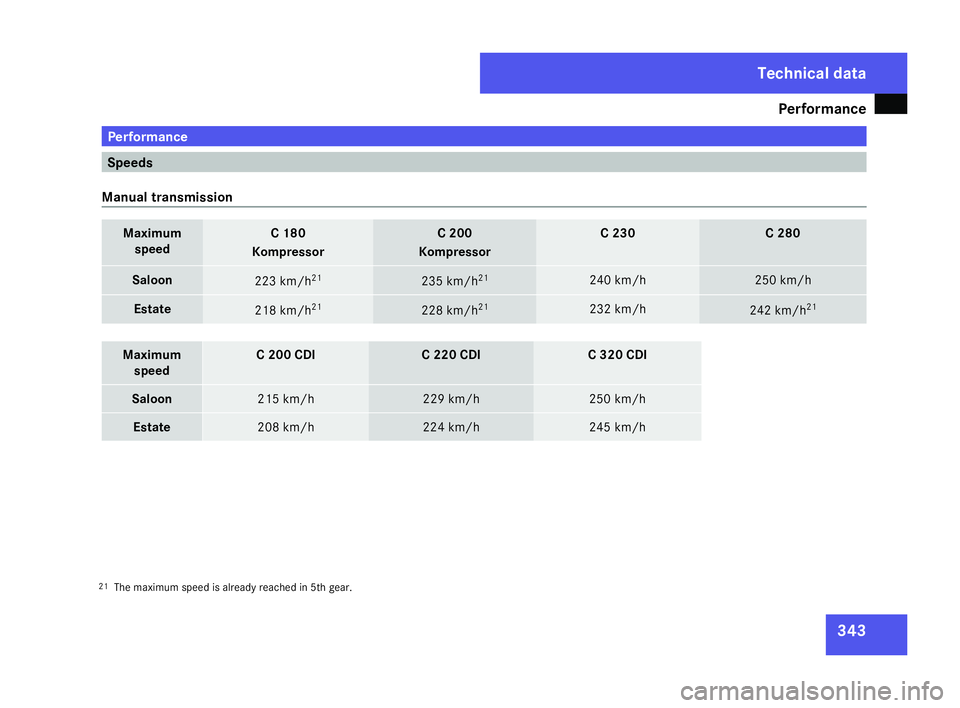
Performance
343Performance
Speeds
Manual transmission Maximum
speed C 180
Kompressor C 200
Kompressor C 230 C 280
Saloon
223 km/h
21 235 km/h
21 240 km/h 250 km/h
Estate
218 km/h
21 228 km/h
21 232 km/h
242 km/h
21 Maximum
spee d C 200 CDI C 220 CDI C 320 CDI
Saloon 215 km/h 229 km/h 250 km/h
Estat
e 208 km/h 224 km/h 245 km/h
21
The maximum speed is already reached in 5th gear. Technical data
204_AKB; 2; 3, en-GB
mkalafa,
2007-06-26T23:11:51+02:00 - Seite 343
Page 347 of 377
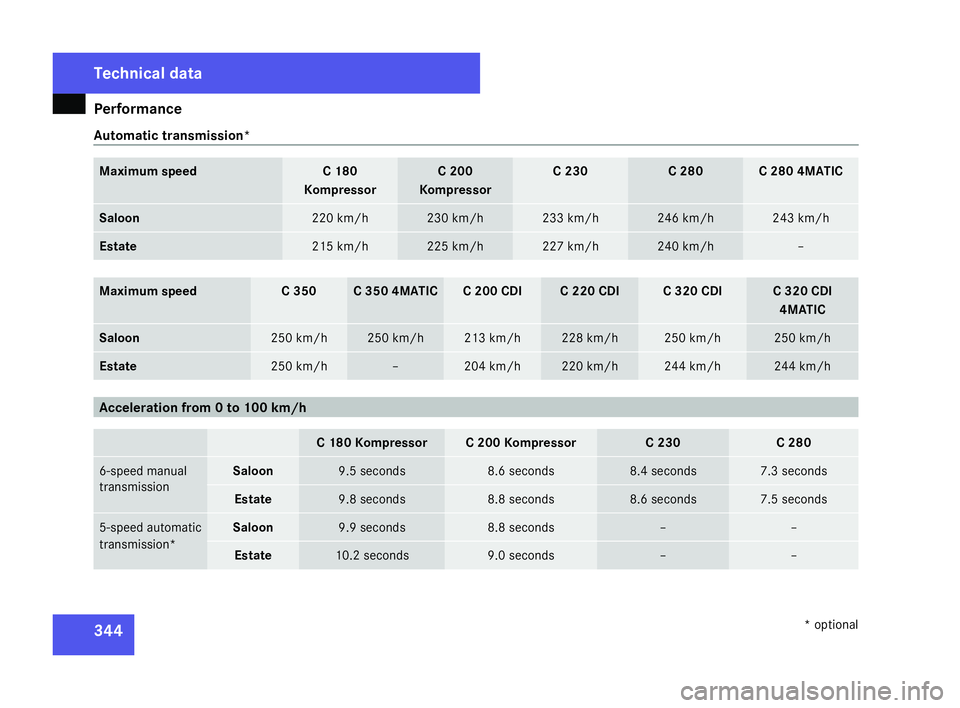
Performance
344
Automatic transmission* Maximum speed C 180
Kompressor C 200
Kompressor C 230 C 280 C 280 4MATIC
Saloon 220 km/h 230 km/h 233 km/h 246 km/h 243 km/h
Estate 215 km/h 225 km/h 227 km/h 240 km/h –
Maximum spee
d C 350 C 350 4MATIC C 200 CDI C 220 CDI C 320 CDI C 320 CDI
4MATIC Saloon 250 km/h 250 km/h 213 km/h 228 km/h 250 km/h 250 km/h
Estat
e 250 km/h – 204 km/h 220 km/h 244 km/h 244 km/h
Acceleration from 0 to 100 km/h
C 180 Kompresso
r C 200 Kompressor C 230 C 280
6-speed manual
transmission Saloon 9.5 seconds 8.6 seconds 8.4 seconds 7.3 seconds
Estat
e 9.8 seconds 8.8 seconds 8.6 seconds 7.5 seconds
5-speed automatic
transmission* Saloon 9.9 seconds 8.8 seconds – –
Estate 10.2 seconds 9.0 seconds – –Techni
cal data
* optional
204_AKB; 2; 3, en-GB
mkalafa,
2007-06-26T23:11:51+02:00 - Seite 344
Page 348 of 377
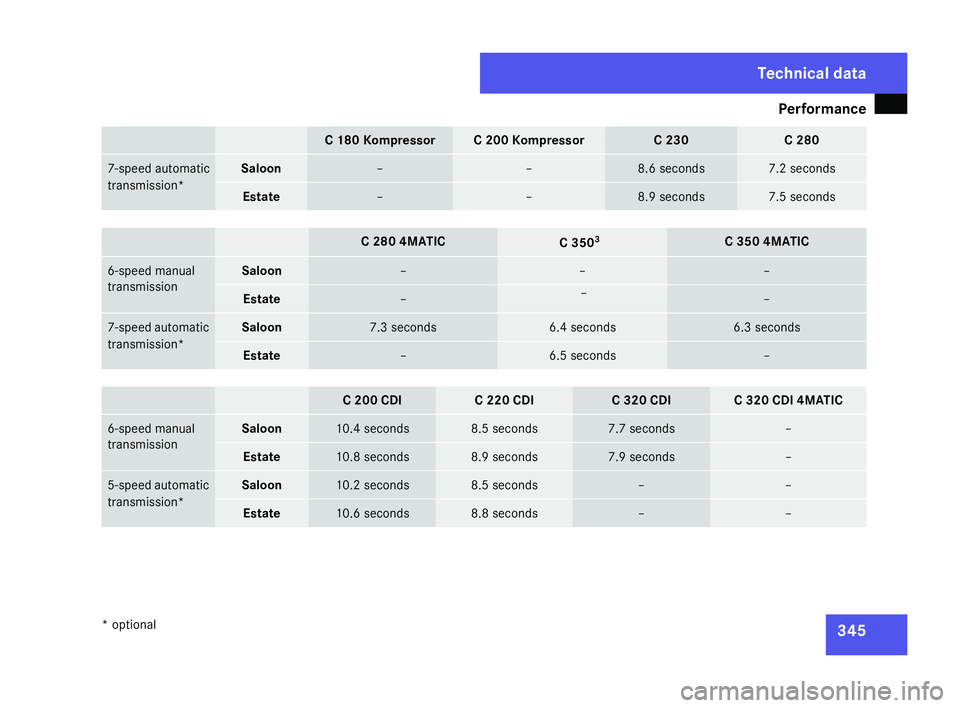
Performance
345C 180 Kompressor C 200 Kompressor C 230 C 280
7-speed automatic
transmission* Saloon – – 8.6 seconds 7.2 seconds
Estate – – 7.5 seconds
C 280 4MATIC
C 350
3 C 350 4MATIC
6-speed manual
transmission Saloon – – –
Estate – –
7-speed automatic
transmission* Saloon 7.3 seconds 6.4 seconds 6.3 seconds
Estate – 6.5 seconds –
C 200 CDI C 220 CDI C 320 CDI C 320 CDI 4MATIC
6-speed manual
transmission Saloon 10.4 seconds 8.5 seconds 7.7 seconds –
Estate 10.8 seconds 7.9 seconds –
5-speed automatic
transmission* Saloon 10.2 seconds 8.5 seconds – –
Estate 10.6 seconds 8.8 seconds – –Techni
cal data
* optiona l
204_AKB; 2; 3, en-GB
mkalafa,
2007-06-26T23:11:51+02:00 - Seite 345 8.9 seconds
–
8.9 seconds
Page 362 of 377
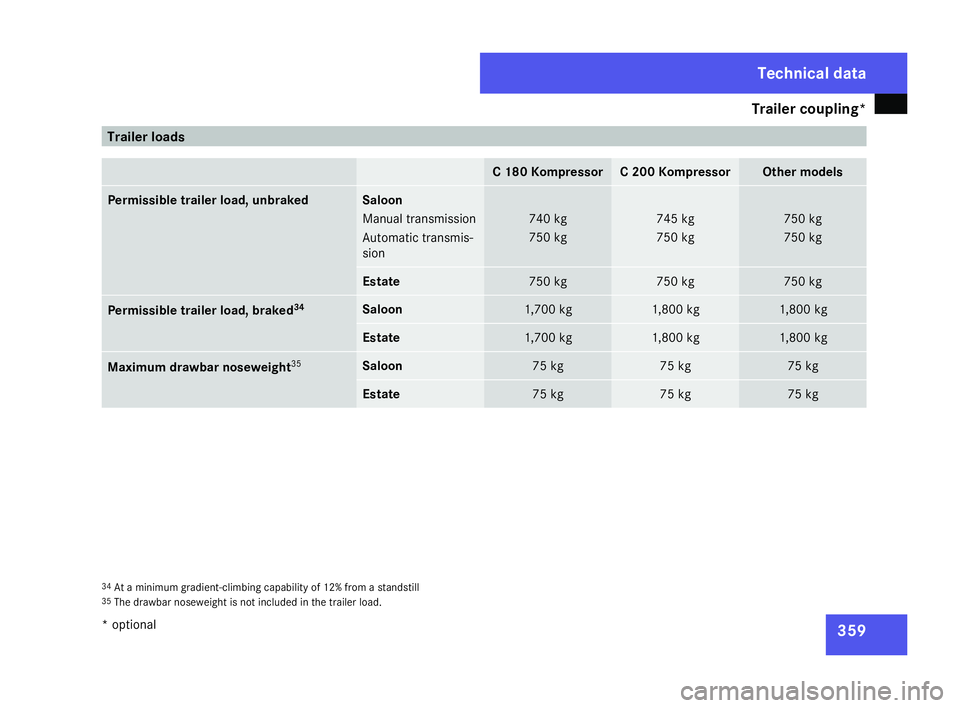
Trailer coupling*
35
9 Trailer loads
C 180 Kompresso
r C 200 Kompressor Other models
Permissible trailer load, unbraked Saloon
Manual transmission
Automatic transmis-
sion
740 kg
750 kg 745 kg
750 kg 750 kg
750 kg
Estat
e 750 kg 750 kg 750 kg
Permissible trailer load, braked
34 Saloon 1,700 kg 1,800 kg 1,800 kg
Estate 1,700 kg 1,800 kg 1,800 kg
Maximum drawbar noseweight
35 Saloon 75 kg 75 kg 75 kg
Estate 75 kg 75 kg 75 kg
34
At a minimum gradient-climbing capability of 12% from a standstill
35 The drawbar noseweight is not included in the trailer load. Technical data
* optional
204_AKB; 2; 3, en-GB
mkalafa,
2007-06-26T23:11:51+02:00 - Seite 359
Page 363 of 377
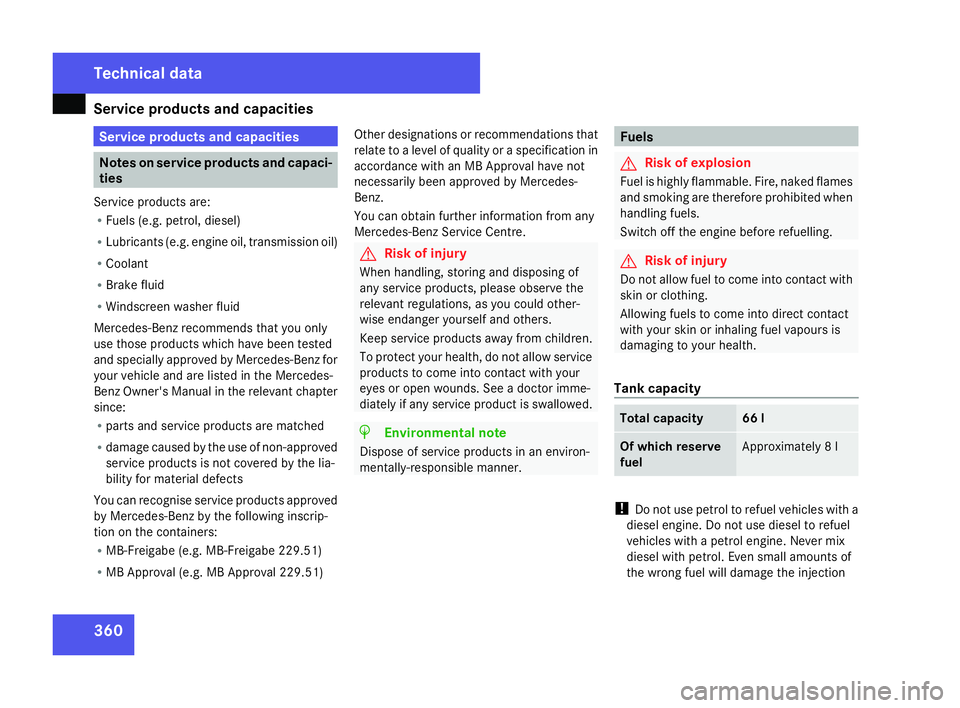
Service products and capacities
360 Service products and capacities
Notes on service products and capaci-
ties
Service products are:
R Fuels (e.g. petrol, diesel)
R Lubricants (e.g. engine oil, transmission oil)
R Coolan t
R Brake fluid
R Windscreen washer fluid
Mercedes-Benz recommends that you only
use those products which have been tested
and specially approved by Mercedes-Benz for
your vehicle and are listed in the Mercedes-
Benz Owner's Manual in the relevant chapter
since:
R parts and service products are matched
R damage caused by the use of non-approved
service products is not covered by the lia-
bility for material defect s
You can recognise service products approved
by Mercedes-Benz by the following inscrip-
tion on the containers:
R MB-Freigabe (e.g. MB-Freigabe 229.51)
R MB Approval (e.g. MB Approval 229.51) Other designations or recommendations that
relate to a level of quality or a specification in
accordance with an MB Approval have not
necessarily been approved by Mercedes-
Benz.
You can obtain further information from any
Mercedes-Benz Service Centre. G
Risk of injury
When handling, storing and disposing of
any service products, please observe the
relevant regulations, as you could other-
wise endanger yourself and others.
Keep service products away from children.
To protect your health, do not allow service
products to come into contact with your
eyes or open wounds. See a doctor imme-
diately if any service product is swallowed. H
Environmental not
e
Dispose of service products in an environ-
mentally-responsible manner. Fuel
s G
Risk of explosion
Fuel is highly flammable. Fire, naked flames
and smoking are therefore prohibited when
handling fuels.
Switch off the engine before refuelling. G
Risk of injury
Do not allow fuel to come into contact with
skin or clothing .
Allowing fuels to come into direct contact
with your skin or inhaling fuel vapours is
damaging to your health.
Tank capacity Total capacity 66
l Of which reserve
fuel Approximately 8
l !
Do not use petrol to refuel vehicles with a
diesel engine. Do not use diesel to refuel
vehicles with a petrol engine. Never mix
diesel with petrol. Even small amounts of
the wrong fuel will damage the injection Technical data
204_AKB; 2; 3, en-GB
mkalafa,
2007-06-26T23:11:51+02:00 - Seite 360